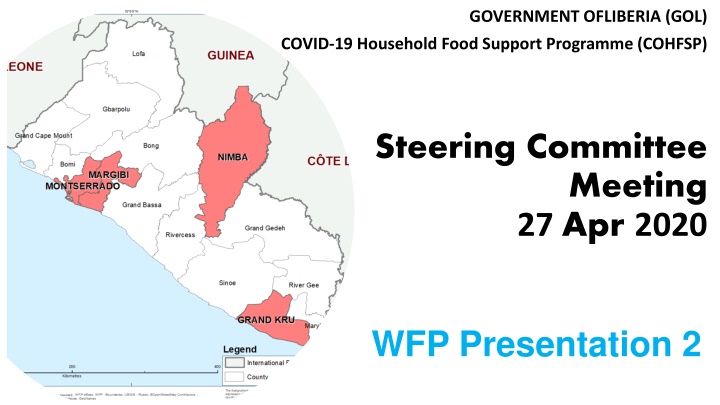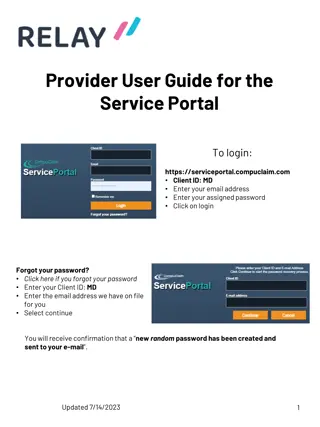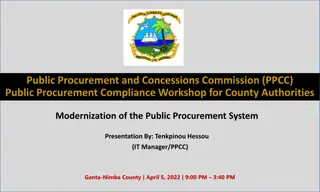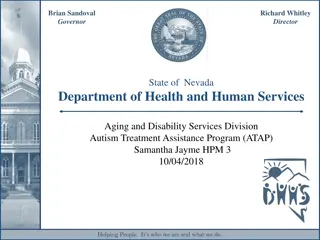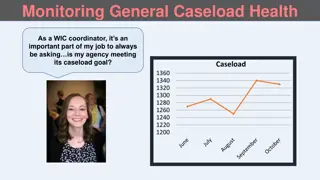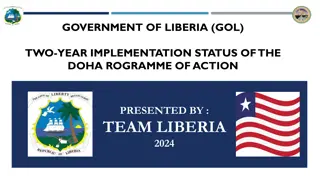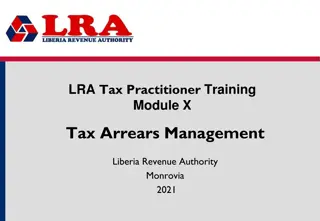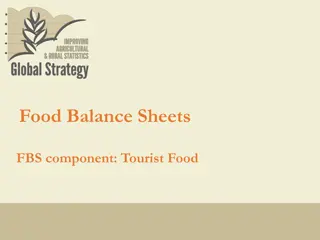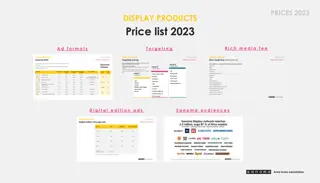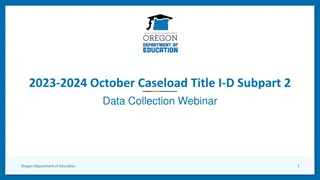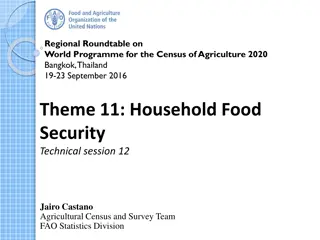Household Food Support Programme in Liberia: Caseload Estimation and Targeting Approach
The Government of Liberia's COVID-19 Household Food Support Programme aims to assist those facing food insecurity in four target counties. Using data from various assessments, the programme estimates a caseload of 1,971,000 individuals. Targeting strategies include geographical and household-level criteria to ensure effective distribution.
Download Presentation

Please find below an Image/Link to download the presentation.
The content on the website is provided AS IS for your information and personal use only. It may not be sold, licensed, or shared on other websites without obtaining consent from the author.If you encounter any issues during the download, it is possible that the publisher has removed the file from their server.
You are allowed to download the files provided on this website for personal or commercial use, subject to the condition that they are used lawfully. All files are the property of their respective owners.
The content on the website is provided AS IS for your information and personal use only. It may not be sold, licensed, or shared on other websites without obtaining consent from the author.
E N D
Presentation Transcript
GOVERNMENT OFLIBERIA (GOL) COVID-19 Household Food Support Programme (COHFSP) Steering Committee Meeting 27 Apr 2020 WFP Presentation 2
Contents Caseload Estimation Targeting Beneficiary Registration Implementation Scenarios Supply Chain & Logistics Distribution Modalities Monitoring
Caseload Estimation The exercise to estimate the caseload for the FSP considered an Oct 2019 food security analysis and mapping process, Integrated Context Analysis (ICA), involving 10 Govt ministries/agencies as well as UN agencies and NGOs The ICA synthesized the results of the five latest food security assessments conducted across Liberia: CFSNS October 2010, EFSMA May 2011, CFSNS November 2012, EFSA June 2015 and CFSNS March 2018 Based on this synthesis, the ICA estimated the number of people who could fall into food insecurity and require assistance in the event of a shock Using LISGIS official population projection for 2020 and the ICA results, WFP has estimated the caseload for the four target counties at 1,971,000 persons: Montserrado: 1,248,000; Margibi: 206,000; Nimba: 455,000; Grand Kru: 62,000 NOTE: costing is based on the estimated caseload; distribution will be based on the stakeholder-validated and community-vetted data from household enumeration
Targeting First-level targeting will begeographical, dictated by GOL s decision to support four counties thru the FSP: Montserrado, Margibi, Nimba, Grand Kru Second-level targeting will be along two strands: institutional and household Institutional targeting will focus on at-risk groups such as disabled people, zogos, the elderly, etc who will be targeted thru relevant Govt entities and other appropriate stakeholders Household-level targeting will be based on the following criteria: Degree to which the community of the household is rural or a slum - e.g: West Point: most likely all HHs; Mamba Point: only HHs in the pockets of mini-slums Household housing type or structure - Temporary shelter (makeshift, zinc shack, mat house, etc.) - Semi-permanent (mud houses, dirt bricks, etc.) - Permanent (Concrete) - Unfinished structure Number of households per structure/housing unit (single vs multiple households within a unit)
Beneficiary Registration Institutional Beneficiaries Beneficiary data to be provided by entities such as MOGD, NGOs, UN agencies, etc Household-level Beneficiaries LISGIS is leading the process with WFP support to develop a beneficiary registration tool/process that will be validated by stakeholders WFP in process of amending current MOU with LISGIS to include beneficiary/household registration for food assistance LISGIS to undertake beneficiary/household registration directly or with support from contracted partners Data collected by LISGIS to be triangulated with secondary data, verified by various means, validated by stakeholders and vetted by communities
Implementation Scenarios Scenario 1: Adjusted Plan (30 feeding days) Scenario 2: Adjusted Plan (14 feeding days) Scenario 3: Technical C ttee Recommended Plan
SCENARIO 1 SCENARIO 1 Food Basket: Feeding Days: 30 Rice 400g Oil 25g Salt 4g Total 429g Ration Size (/person/day): Food Requirement: Food Price (USD/mt): Food Cost (USD): 12,000mt $500 $6.0mil 750mt $1,200 $0.9mil $0.04mil 120mt $300 12,870mt n/a $6.94mil Benefi- ciaries: 1.0mil Food Sourcing Discussed later
SCENARIO 2 SCENARIO 2 Food Basket: Feeding Days: 14 Rice 400g Oil 25g Salt 4g 56mt $300 Total 429g Ration Size (/person/day): Food Requirement: Food Price (USD/mt): Food Cost (USD): 5,600mt $500 $2.8mil 350mt $1,200 $0.42mil $0.02mil 6,006mt n/a $3.24mil Benefi- ciaries: 1.0mil Food Sourcing Discussed later (as with Scenario 1)
SCENARIO 3 SCENARIO 3 Food Basket: Ration Size (/HH/mth): Requirement: Food Price (USD/mt): Cost (USD): Feeding Months: 2 Rice 50kg Oil 1gal Gari 5kg Cash Total MT $14 59.5kg (4.5kg) 3,548mt $1,100 $3.90mil $3.94mil $11.04m$38.59mil 39,420mt $500 $19.71mil 3,942mt $11.04m 46,910mt $1,000 House- holds: 394,200 n/a Food Sourcing Gari would be sourced locally As much local red palm oil and locally produced rice as can be speedily supplied within specifications would be procured to meet the oil and rice need Any gap between what is needed and what can be supplied from locally produced commodities would be met from imported stocks available locally. NOTE: WFP will likely not be able to buy gari. Consider adding gari into cash portion!!
SUPPLY CHAIN (Procurement & Logistics)
Supply Chain: Food Sourcing & Procurement To support the public health emergency response and in order to reach beneficiaries urgently, WFP will apply the following approach: WFP will source required food from available in-country stocks Rice will be mostly imported rice sourced from locally-based rice importers As much local rice and red palm oil as can be speedily supplied will be procured The rest of the requirements will be obtained locally from imported stocks
Supply Chain: How WFP Procures Food WFP depends on reliable and reputable suppliers and will therefore only purchase from pre-qualified suppliers. The criteria to become a WFP vendor include the following: o The commodity is relevant to WFP s operational needs; o Vendor holds legal qualification to enter into a contract with the United Nations; o Relevant food commodities -- cereals, pulses, edible oil and/or processed commodities (such as wheat flour, blended foods and high energy biscuits) -- must be part of the company s core business; o Proven financial standing to honor a contract; o Proven ability to perform; o Minimum of three years experience as an established business; o WFP s general terms and conditions, including its payment terms are accepted by the Vendor. How suppliers get contracted: o WFP uses electronic tendering through the In-Tend web-platform and suppliers are invited to compete for contracts through a Request for Quotation (RFQ). o The total lowest delivered offer (food + transport) is presented to a purchase committee consisting of non-procurement staff for their endorsement and final recommendation to the Procurement Authority. o The supplier with the best offer gets notified through a Note of Award and contract gets signed. Inspection of Food Commodities: WFP appoints an independent third party inspection company to verify that consignments conform to contractual terms in respect of quality and quantity Payment Terms: Cash against documents: electronic transfer of funds against shipping documents. WFP does not accept requests for letters of credit, advance payment or third party payments.
Supply Chain: Transport & Handling In addition to speedy procurement (encompassing the pre-delivery process and the handover of commodities to WFP), the viability of this intervention depends in large measure on effective transport and handling. Two critical success factors for in this regard are trucking capacity and casual labour capacity (for loading onto trucks). WFP is planning to complete delivery of the approx. 13,000mt of food in ten days. This would require at least 1,300mt of trucking capacity (e.g. 65 trucks with average payload of 20mt) and commensurate casual labour loading capacity to deliver the food to all locations within the planned days. To date, WFP has confirmed availability of 273 acceptable trucks with average payload of 22.7mt, equivalent to a total payload of 6,000+ mt.
Supply Chain:Transport & Handling (contd) With the rains here, the roads to southeastern Liberia will start their seasonal deterioration. This has implications for deliveries to Grand Kru To help mitigate the related risks, WFP is looking to establish a sea route (Monrovia/Harper) to the planned logistics staging area in Barclayville A vessel has been identified with capacity of 400mt/6.5days, This means that sea transport may have to be a secondary option for delivery from Monrovia. Loading for delivery to distribution points remains fraught with challenges. WFP would require capacity to load some 1,300mt a day. To cut down on lead-time, WFP was looking to move stocks from the facilities of suppliers straight to distribution points. This would mean using the facilities of suppliers as loading points. But it would also mean operating with suppliers with facilities adequate for such operations and with enough stocks to serve a large enough portion of the requirements to warrant setting up a WFP mobile commodity tracking and accounting station with associated hardware and software systems.
Supply Chain:Transport & Handling (contd) However, if the suppliers turn out to be a large number of suppliers, each providing relatively small portions of the requirements, WFP may have to first receive stocks from all such suppliers in its warehouses (involving offloading of the commodities) and then organize loading operations for delivery to distribution points. This will of course increase the lead-time of the overall delivery operation. Aside the foregoing, WFP has been working with some of the big potential suppliers to plan possible loading operations. Of the three that have complied, loading capacity is less than what is required, and WFP is looking at options to ramp up this capacity, including running 24-hour truck loading operations (e.g. four six-hour shifts) at different loading points. Additionally, to ensure speedy truck rotation, offloading at final delivery points in Montserrado County communities (which will be principally done by community members) will be supported by experienced WFP casual labour teams deployed with delivery convoys.
Supply Chain: Logistics Services A range of commercial logistics services will be required for this intervention, including cargo superintendence, cargo transport, casual labour, and possible warehousing in Grand Kru. WFP already has a standing contract for cargo superintendence with a Liberia-registered company valid until December 2020. WFP also has a current contract for the casual labour services with a Liberian-owned company that is valid until December 2020. For cargo transport, WFP implements a tariff-based system for all routes, i..e established rates, (as opposed to agency agreements).
Supply Chain:Logistics Services (contd) WFP s current vendor roster includes seven Liberian-owned transport companies. Due to this operation, WFP is in the process of updating the vendor roster to accommodate additional commercial transport capacity. Other logistics services such as warehousing and others will be provided directly by WFP. In the case of warehousing in Grand Kru. WFP will consider using available mobile storage capacity handed over to the government in Barclayviille. If this option proves untenable, WFP will work to secure other alternatives including commercial alternatives
Distribution Modalities APPROACH To support the public health emergency response and in order to reach communities within the targeted counties, WFP will apply social-distancing measures put in place by the Incident Management System (IMS) of the National Public Health Institute of Liberia (NPHIL)/Ministry of Health. The intervention will be largely organized through community-based structures. Organisations representing women, youth and people living with disabilities, among other vulnerable groups, will be included in the decision-making processes, while gender-responsive monitoring mechanisms will also be applied As a preventive mechanism to counter gender-based violence that may result from containment measures, including domestic violence and sexual exploitation and abuse, WFP will leverage its Complaints and Feedback Mechanism (CFM) system to enable beneficiaries to call in and register their concerns. The CFM is a centralized system for receiving and managing feedback and complaints, as well as improving communication, accountability, transparency and programme quality. WFP will ensure collaboration with partners
Distribution Modalities PARTNERSHIP WFP will implement the distribution in collaboration with community people and using the services of NGO partners These partners will be selected through a fair and competitive process. There are currently 17 NGOs on WFP shortlist of Cooperating Partners (CPs), which are all NGOs WFP will send request for proposals (RFPs) to NGOs on the shortlist and assess them based on a set of pre-determined criteria, including having proper legal status and updated up-to-date accreditation Those CPs determined to be most cost-effective to work with will be selected to support the distribution process.
Distribution Modalities FOOD DISTRIBUTION DAY On distribution days, household representatives will be organized to receive their distributions in line with MOH/NPHIL prescribed COVID-19 safety measures and the WFP SOP for COVID-19 food distribution CPs will take the lead on this with the guidance and support of WFP Programme staff in collaboration with community leaders Other stakeholders will be encouraged to monitor and observe the process with full compliance to health measures As much as feasible, food will be delivered at distribution points and food distribution will be carried during the lockdown hours to avoid crowding Food recipients will be called to the distribution points in small groups of 5 to 10 at a time. Direct delivery to households in the immediate vicinity of distribution centers would be considered for some locations WFP will ensure that mechanisms are in place in each community for beneficiaries to register complaints and provide feedback on issues related to the food distribution
Monitoring In view of COVID-19 containment measures such as social distancing, WFP will work along two main paths to monitor this intervention: (a) remote data collection for post-distribution monitoring and (b) complaints and feedback mechanisms (CFM) systems (operated remotely by phone). Joint monitoring will also be done with stakeholders. All data collected from monitoring activities will be disaggregated by sex, age and disability status. During beneficiary registration, WFP will work with partners to ensure that mobile numbers for heads of household are collected. This will enable WFP to conduct post-distribution monitoring, which will provide essential information on accountability to affected populations and beneficiary protection. Additionally, WFP will use its CFM system to receive and respond to the concerns of beneficiaries on a day-to-day basis. The CFM hotlines work with the two GSM service providers in Liberia (2121 on Orange and 2323 on LoneStar Cell MTN). WFP will use radio and other media outlets to communicate the CFM hotline numbers to the population in Montserrado, Margibi, Grand Kru and Nimba counties.
We look forward to the feedback by the Steering Committee on aspects of this intervention to slow the spread of COVID-19 Thank you
